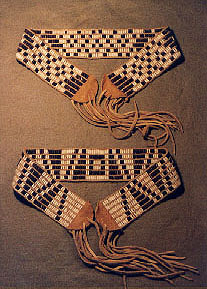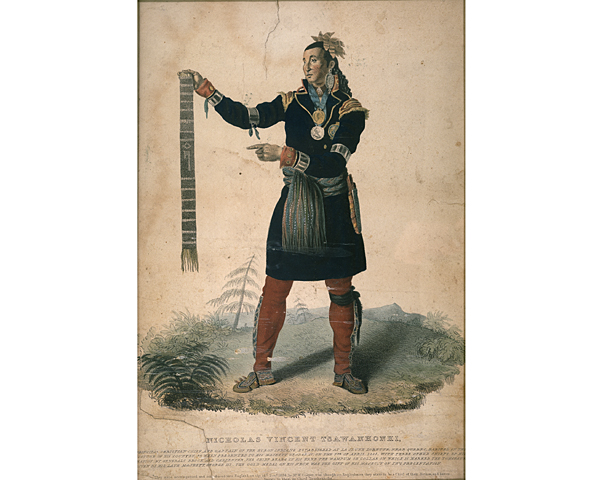|
|
Online Texts
for
|
|
|
selections from The Great Law of Peace (see also wampum)
|
|
Around or before 1500 CE, the Iroquois prophet and law-giver Dekanawidah or Deganawida, “The Great Peacemaker,” founded with Hiawatha (a political orator and leader) the Iroquois Confederacy, also known as the Haudenosaunee or "People of the Long House," a.k.a. "the Five Nations" or, later, the "Six Nations."
The great Iroquois revivalist Handsome Lake appeared two or three centuries later.
The text appears here in a written or recorded form, but it lived (and continues to live) as a spoken-word constitution, with wampum as a memory aid or prompt. As a spoken text, this constitution allows for rhetorical development or ornamentation, in contrast to our written culture's respect for the precise written words of, say, the Bible or the U.S. Constitution.
![]()
The Constitution of the Iroquois Nations (Gerald Murphy translation)
The Great Binding Law
GAYANASHAGOWA
|
[1] 1. I am Dekanawidah and with the Five Nations' Confederate Lords I plant the Tree* of Great Peace. I plant it in your territory, Adodarhoh, and the Onondaga Nation, in the territory of you who are Firekeepers. [The Onondaga Nation of the Iroquois kept the constitution's wampum and its council fire; in the belt pictured above the Onandaga are represented by the central tree.] |
|
|
[2] I name the tree the Tree of the Great Long Leaves. Under the shade of this Tree of the Great Peace we spread the soft white feathery down of the globe thistle [>] as seats for you, Adodarhoh, and your cousin Lords. [3] We place you upon those seats, spread soft with the feathery down of the globe thistle, there beneath the shade of the spreading branches of the Tree of Peace. There shall you sit and watch the Council Fire of the Confederacy of the Five Nations, and all the affairs of the Five Nations shall be transacted at this place before you, Adodarhoh, and your cousin Lords, by the Confederate Lords of the Five Nations. |
|
[4] 2. Roots have spread out from the Tree of the Great Peace, one to the north, one to the east, one to the south and one to the west. The name of these roots is The Great White Roots and their nature is Peace and Strength. [note metaphorical extension: tree > roots; "white" may refer to color of shells in other wampum settings, or to color of roots]
[5] If any man or any nation outside the Five Nations shall obey the laws of the Great Peace and make known their disposition to the Lords of the Confederacy, they may trace the Roots to the Tree and if their minds are clean and they are obedient and promise to obey the wishes of the Confederate Council, they shall be welcomed to take shelter beneath the Tree of the Long Leaves.
[6] We place at the top of the Tree of the Long Leaves an Eagle who is able to see afar. If he sees in the distance any evil approaching or any danger threatening he will at once warn the people of the Confederacy. [another figurative development: tree > eagle roost (extended metaphor)]
[7] 3. To you Adodarhoh, the Onondaga cousin Lords, I and the other Confederate Lords have entrusted the caretaking and the watching of the Five Nations Council Fire. [Onandaga tribe also kept wampum records of treaties & transactions--represented by "tree" at center of wampum belt at top]
[8] When there is any business to be
transacted and the Confederate Council is not in session, a messenger shall be
dispatched either to Adodarhoh, Hononwirehtonh or Skanawatih, Fire Keepers, or
to their War Chiefs with a full statement of the case desired to be considered.
Then shall Adodarhoh call his cousin (associate) Lords together and consider
whether or not the case is of sufficient importance to demand the attention of
the Confederate Council. If so, Adodarhoh shall dispatch messengers to summon
all the Confederate Lords to assemble beneath the Tree of the Long Leaves.
[Later articles are not numbered]
[9] When the Lords are assembled
the
Council Fire shall be kindled, but not with chestnut wood*, and
Adodarhoh shall formally open the Council. Then shall Adodarhoh and his cousin
Lords, the Fire Keepers, announce the subject for
discussion. [*"not with chestnut wood" . . . editor's note: chestnut wood throws
out sparks in burning, thereby creating a
disturbance in the council]
[10] The
Smoke of the Confederate
Council Fire shall ever ascend and pierce the sky so that other
nations who may be allies may see the Council Fire of the
Great Peace. [fire > smoke; is this communication
to allies a form of "smoke signals?"]
[11] Adodarhoh and his cousin Lords are
entrusted with the Keeping of the Council Fire.
|
[12] A bunch of a certain number of shell (wampum) strings each two spans in length shall be given to each of the female families in which the Lordship titles are vested. The right of bestowing the title shall be hereditary in the family of the females legally possessing the bunch of shell strings and the strings shall be the token that the females of the family have the proprietary right to the Lordship title for all time to come, subject to certain restrictions hereinafter mentioned. [some tribes entrusted women as record-keepers or tribal memory.] [13] Any Lord of the Five Nations Confederacy may construct shell strings (or wampum belts) of any size or length as pledges or records of matters of national or international importance.
|
|
[14] When it is necessary to dispatch a shell string by a War Chief or other messenger as the token of a summons, the messenger shall recite the contents of the string to the party to whom it is sent. That party shall repeat the message and return the shell string and if there has been a summons he shall make ready for the journey. [As a "written" text the wampum message serves as a sign or "token" of authority, but since "word pictures" may have multiple meanings, the recipient must hear and repeat the message associated with the text] [15] Any of the people of the Five Nations may use shells (or wampum) as the record of a pledge, contract or an agreement entered into and the same shall be binding as soon as shell strings shall have been exchanged by both parties.
|
|
|
[16]
A bunch of wampum shells on
strings,
three spans of the hand in length, the upper half of the bunch being white and
the lower half black, and
formed from equal
contributions of the men of the Five Nations, shall be a token that the men have
combined themselves into one head, one body and one thought,
and it shall also symbolize their ratification of the peace pact of the
Confederacy, whereby the Lords of the Five Nations have established the Great
Peace. [18] A broad dark belt of wampum of thirty-eight rows, having a white heart in the center, on either side of which are two white squares all connected with the heart by white rows of beads shall be the emblem of the unity of the Five Nations. [ed. note: This is the Hiawatha Belt, now in the Congressional Library.] [instructor: the editor's certainty is questionable, but see illustration below and at top.]
|
|
[19]
The first of the
squares on the left represents the Mohawk nation and its territory;
the second square on the left and the one near the
heart,
represents the Oneida nation and its
territory;
the white heart
in the middle represents the
Onondaga nation
and its territory, and it also means that the heart of the Five Nations is
single in its loyalty to the Great Peace, that the Great Peace is lodged in the
heart (meaning the Onondaga Lords), and that
the Council Fire is to burn there for the Five Nations,
and further, it means that the authority is given to advance the cause of peace
whereby hostile nations out of the Confederacy shall cease warfare; the white
square to the right of the heart represents the
Cayuga
nation and its territory and the fourth and last white square represents the
Seneca
nation and its territory.
[20]
White shall here symbolize
that no evil or jealous thoughts shall creep into the minds of the Lords while
in Council under the Great Peace.
White, the emblem of peace, love, charity and
equity surrounds
and guards the Five Nations. [a white symbol potentially
independent of the "color code"]
![]()
![]()
![]()
![]()
![]()
![]()
![]()
![]()
![]()
![]()





